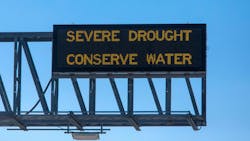Water, water every where – but not a drop to use for industry. Apologies to Samuel Taylor Coleridge for modifying a line from “The Rime of the Ancient Mariner.” But it illustrates that droughts are no joke for the chemical industry. In fact, earlier this year, several chemical companies in Tampico, Tamaulipas, Mexico – about 400 miles south of San Antonio, Texas — were asked to minimize their water intake due to drought. Tampico is a city and port located on the north bank of the Pánuco River, about six miles inland from the Gulf of Mexico.
Indeed, on May 24, 2024, Orbia Polymer Solutions sent out a notice of force majeure. It was one of many facilities in the area that had to shut down during the height of the drought.
“On May 21, 2024, our production facilities in Altamira, Mexico, were severely impacted by the current situation in Tampico, Tamaulipas Mexico. Due to extreme temperatures and drought causing a scarcity of water, our water supply sources were depleted, interrupting water supply to both industry and residents. This led to a complete shutdown of the facility. This event was not foreseeable and is not under our control.
Given the effects of such an event, we will not be able to fulfill our obligations.
We sincerely regret any inconvenience this causes your company and thank you for your cooperation and understanding of these extraordinary circumstances.”
To mitigate drought impacts, chemical manufacturers should consider implementing water conservation measures, investing in water recycling and treatment technologies, diversifying water sources, adjusting production schedules or modifying process chemistry to reduce water consumption.
Water Source Challenges
While some market players have started with better water management strategies for plants in water-stressed areas, others are diving in deep, recognizing that even areas where water is plentiful can suffer from source challenges, including drought, source contamination from storms or even other industries nearby.
Decisions to invest in water management must make financial sense. However, spending money to treat water could be offset by less discharge and less supply needed through reuse or recycling.
Historically, water hasn’t been the focus of the chemical industry. Financial, social and environmental pressures have concentrated on greenhouse gas emissions and waste management. But the tides are changing.
More companies are publishing targets for water management. And water shortages across the world's leading freshwater basins are becoming chronic. Such scarcity has impact beyond a facility or a product and can lead to increased electricity costs, chemical costs and consumer shifts. Thus, corporate risks around water use are climbing and investors are taking note. A 2020 McKinsey article describes that overall water management includes raw materials, suppliers, operations and eventual product use (1). This explains why we now see commercials stressing the water content of competitor detergents or the rise in incentives for smart appliances and home devices that monitor and control water usage. These market shifts help to decrease business risks, and companies are paying attention.
Risk Mitigation Options
In the chemical industry, the primary use of water in operations is not in the product itself but in heating and cooling processes. This means that businesses are assessing their local supplies or lack thereof, as well as their consumption rates to identify risk mitigation options. Not only is the lack of surface water a rising issue, but areas with plenty of surface water may face issues with groundwater reservoir depletion. Land subsidence, historical industrial or agricultural withdrawals, or saltwater intrusion are all groundwater risks to a plant. Where pure water is part of the product or process, degradation in supply quality and quantity lead to growing concerns (2). Treatment may need to be intensified, and monitoring may need to be increased to safeguard product quality and productivity in addition to the water used for heating and cooling.
Reuse often comes to mind as a potential solution to reduce risk, but some view it more as a cost. Terminology is emerging across and within industry segments to identify tangible ways to reuse.
Here are three ways that water can be conserved and reused.
● Using treated wastewater as a substitute for source water – This approach takes water already being treated for discharge to lessen costs and intake of source water. There may be challenges with the level of treatment possibly leading to tertiary or even quaternary treatment, or possibly just further disinfection.
● Recycling water onsite – One example of this approach is returning condensate to add to boiler makeup, which often requires polishing to eliminate contaminants. In this case, it is important to prevent contaminants that could lead to corrosion, scaling or deposition. Another example is using treated wastewater for washing, rinsing or cooling, which tend to have lower quality requirements. Here, the contaminants that need to be removed include microbes, salts and organics.
● Reclaiming water to be used in the product or production process – This approach is a tougher task because the product or process may be sensitive to certain contaminants. Knowing the product quality requirements will help identify key contaminants and the associated treatment to be applied.
Integrating wastewater management with source water usage creates a more efficient water cycle. Facilities that already collect and treat onsite production water as wastewater should consider reusing this treated effluent onsite. This approach offers several benefits:
- Reduced source water intake
- Decreased wastewater discharge
- Lower risk due to using a known water quality
Implementing better water management practices can mitigate risks associated with water scarcity:
- Minimizing freshwater consumption\
- Recycling treated wastewater
- Reusing water onsite
These strategies not only address financial and competitive risks but also enhance sustainability. Historically, industrial facilities have been linked to environmental issues such as pollution, groundwater depletion and high water consumption. By adopting improved water management techniques, plants can now take concrete steps to conserve and protect water resources.
References
- Hundertmark, Thomas; Leuck, Kun; Packer, Brent. Water: A human and business priority. 5 May 2020. McKinsey Quarterly. https://www.mckinsey.com/capabilities/sustainability/our-insights/water-a-human-and-business-priority
- Milmo, Sean. “Thirsty Work.” September 2008. Chemistry World. Water Industry_tcm18-131652.pdf (rsc.org).
About the Author
Amanda Tyndall
Amanda Tyndall is the Vertical Market Manager Industrial & Environmental for Veolia Water Technologies & Solutions Analytical Instruments. With 10 years experience in the water industry, Amanda and her team partner with industries and municipalities to solve water quality challenges through instrumentation solutions from ultrapure water to wastewater. Her background is in chemical engineering with a Bachelor's Degree from Vanderbilt University and a Masters Degree from University of Cambridge.

